Multiple Response
Identify one
or more choices that best complete the statement or answer the question.
|
|
|
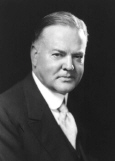
Herbert Hoover | 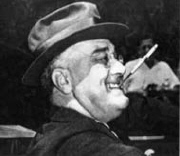
Franklin Delano Roosevelt | New Deal Actions
In 1932, the presidential election showed that
Americans were clearly ready for a change . Because of the Depression, people were suffering from
lack of work, lack of food, and lack of hope.
| | | |
ELECTING FRANKLIN DELANO ROOSEVELT
Although the Republicans
renominated President Hoover as their candidate, they recognized that he had little chance of
winning. Too many Americans blamed Hoover for doing too little about the Depression and wanted
a new president in the White House.
The Democrats pinned their hopes on Franklin Delano
Roosevelt, known popularly as FDR, the two-term governor of New York and a distant cousin of
Theodore Roosevelt. As governor, Franklin Roosevelt had proved an effective, reform-minded leader. He
pushed a series of new measures through the New York legislature to combat the problems of
unemployment and poverty. Unlike Hoover, Roosevelt projected an air of friendliness and confidence
that attracted voters . Though practical at heart, he had a creative, adventurous side that allowed
him to take risks that others might avoid. As he once said, "It is corrimon sense to take a
method and try it. If it fails, admit it frankly and try another. But above all, try something."
This "can-do" attitude appealed to a public that regarded Hoover, rightly or wrongly, as a
"do-nothing" president.
Roosevelt won an overwhelming victory, capturing 23 million
votes to Hoover's 16 million and carrying the South, the West, and all but six states in the
Northeast . In the Senate, Democrats claimed a nearly two-thirds majority. In the House, they won
almost three-fourths of the seats, their greatest victory since before the Civil
War.
|
|
|
1.
|
Who did the American people
blame for the Great Depression?
|
|
|
2.
|
Who was the Democrat candidate
for President in 1932?
|
|
|
3.
|
Who won the Presidential
election in a landslide in 1932?
|
|
|
4.
|
Which candidate for President
in 1932 had a “can do” attitude that gave the American people hope?
|
|
|
WAITING FOR
ROOSEVELT
Four months would elapse between Roosevelt's
victory in November and his inauguration as president in March 1933. The Twentieth Amendment, which
moved presidential inaugurations to January, was not ratified until February 1933 and did not apply
to the 1932 election. Americans waited anxiously to find out what plans their new president had for
solving the nation's problems. Meanwhile, the economy continued to worsen . Industrial
production fell; more businesses and banks shut down; and more people lost their jobs, their homes,
and their farms.
FDR was not idle during this waiting period, however. He worked with his team
of carefully picked advisers-a select group of professors, lawyers, and journalists known as the
brain trust. Roosevelt began to formulate a set of policies for his new administration .
This program, designed to alleviate
the problems of the Great Depression, became known as the New Deal, from a phrase in a campaign
speech in which Roosevelt had promised " a new deal for the American people ." New Deal
policies focused on three general goals : relief for the needy, economic recovery, and financial
reform .
On taking office, the Roosevelt administration launched into a period of intense
activity, known as the Hundred Days, lasting from March 9 to June 16, 1933. During this
period, Congress passed more than 15 major pieces of New Deal legislation. These laws, and others
that followed, significantly expanded the federal government's role in the nation's
economy.
|
|
|
5.
|
The election for president took
place in November. How long did the American people have to wait until Roosevelt took
office?
|
|
|
6.
|
Roosevelt devised a program to
alleviate the problems of the Great Depression. What was his program called.
|
|
|
7.
|
Roosevelt got busy right away
devising programs and policies to ease the effects of the Depression. What was this time period
called?
|
|
|
REFORMING BANKING AND
FINANCE
Roosevelt's
first step as president was to carry out reforms in banking and finance . By 1933, widespread
bank failures had caused most Americans to lose faith in the banking system. On March 5, one day
after taking office, Roosevelt declared a bank holiday and closed all banks to prevent further
withdrawals . Then he persuaded Congress to pass the Emergency Banking Relief Act, which
authorized the Treasury Department to inspect the country's banks. Those that were sound could
reopen at once; those that were insolvent-unable to pay their debts-would remain closed . Those that
needed help could receive loans. This measure revived public confidence in banks, since
customers now had greater faith that the open banks were in good financial shape.
AN
IMPORTANT FIRESIDE CHAT
On March 12, the day before the first banks were to reopen,
President Roosevelt boosted confidence further through the first ofhis many fireside chats. These
were radio talks that Roosevelt gave occasionally about issues of public concern, explaining
in clear, simple language his New Deal measures . Informal and relaxed, these talks made
Americans feel as if the president were talking directly to them . In his first chat, President
Roosevelt explained why the nation's welfare depended on public support of the government and
the banking system . "We have provided the machinery to restore our financial system," he
said. "It is up to you to support and make it work." This is how he explained the banking
system .
The president then explained that when too many people demanded their savings in
cash, banks would fail. This did not mean that the banks were weak, because even strong banks could
not meet such heavy demands.
Over the next few weeks, many Americans returned their savings
to banks . Congress took another step to reorganize the banking system by passing the
Glass-Steagall Banking Act of 1933. Among other provisions, this law established the
Federal Deposit Insurance Corporation (FDIC), which provided federal insurance for
individual bank accounts of less than $5,000 . The Glass-Steagall Banking Act reassured millions
of bank customers that their money was safe. Congress and the president also took steps to
regulate the stock market, which had suffered a tremendous loss of credibility in the crash of 1929.
The Federal Securities Act, passed in May 1933, required corporations to provide complete
information on all stock offerings and made them liable for any misrepresentations. The following
year, in June 1934, Congress created the Securities and Exchange Commission (SEC) to regulate the
stock market. One of the goals of this commission was to prevent people with inside information
about companies from "rigging" the stock market, causing prices to go up or down for their
own profit, regardless of the real value of the stocks
In addition, Roosevelt persuaded
Congress to approve a bill allowing the manufacture and sale of some alcoholic beverages . This bill
included an alcohol tax designed to raise government revenues . By the end of 1933, the
passage of the Twenty-first Amendment had repealed prohibition altogether.
|
|
|
8.
|
Why were the American people
loosing faith in the banking system?
|
|
|
9.
|
One of the first actions that
Roosevelt took was to declare a Bank Holiday. What was a Bank Holiday?
|
|
|
10.
|
What was the Glass Steagall
Banking Act of 1933
|
|
|
11.
|
Roosevelt went on the radio to
boost the confidence of the American people. What were these radio broadcasts
called?
|
|
|
12.
|
What was the purpose of the
Federal Deposit Insurance Corporation (FDIC)?
|
|
|
13.
|
In June, 1934 Congress
established the Securities and Exchange Commission (SEC). What was the
purpose of this organization? (pick 2)
|
|
|
14.
|
Which Constitutional Amendment
repealed prohibition?
|
|
|
Helping the American
People
While working on
banking and financial matters, the Roosevelt administration implemented programs to provide relief to
farmers . It also aided other workers and attempted to stimulate economic
recovery.
ASSISTING
FARMERS
The Agricultural Adjustment Act (AAA) sought to raise crop prices by lowering
production, which the government achieved by paying frriners to leave a certain amount of every
acre of land unseeded. The theory says that reduced supply would boost prices . In some cases
crops were too far advanced for the acreage reduction to take effect . As a result, the govermnent
paid cotton growers 5200 million to plow under 10 million acres of their crop. It also paid hog
farmers to slaughter 6 inillion pigs. This policy upset many Americans, who protested the destnrction
of food when many people were going hungry. It did, however, help raise firm prices and put more
money in farmers' pockets .
HELPING PEOPLE WITH HOUSING
A number of'
New Deal programs concerned housing and home mortgage problems. The Home Owners Loan Corporation
(HOLC) provided government loans to homeowners who faced foreclosure because they couldn't
meet their loan payments. In addition, the National Housing Act created the Federal Housing
Administration (FHA) . This agency continues to furnish loans for home mortgages and repairs
today.
|
|
|
15.
|
How did the Agricultural Adjustment Act (AAA) attempt to help farmers?
|
|
|
16.
|
What was the FHA designed to
do?
|
|
|
PROVIDING WORK
PROJECTS
The administration
also established programs to provide relief through work projects and cash payments . One important
program, the Civilian Conservation Corps (CCC), put young men, aged 18 to 25, to work building
roads, developing parks, planting trees, and helping in soil erosion and flood-control projects . The
CCC paid a small wage, $30 a month, of which $25 was automatically sent home to the worker's
family. It also supplied free food and uniforms . By the tune the program ended in 1942, almost 3
million young men had passed through the CCC. Man- of the camps were located on the Great Plains,
where, within a period of eight years, the men of the CCC planted more than 200 million trees . This
tremendous reforestation program was aimed at preventing another Dust Bowl .
Another program,
the Federal Emergency Relief Administration (FERA), seas funded with $500 million to provide
direct relief for the neadv. Half of the rnoney was given to the states as direct grants-in-aid to
help fin-furnish food and clothing to the unemployed, the aged, and the ill . An additional 5250
million was distributed on the basis of one federal dollar for every three state dollars contributed.
Harry Hopkins, who headed this program believed that money helped people buy food, bit work enabled
them to gain confidence and self-respect
The Public Works Administration (PWA),
created in June 1933, provided money to states to create jobs. These were chiefly in the construction
of schools and other community buildings . \When these programs failed to make a sufficient dent in
unemployment, President Roosevelt established the Civil Works Administration (CWA) in November
1933. It provided 4 million immediate jobs during the winter of 1933-1934. Some critics of the CWA
claimed that the programs were "make-work" projects and a waste of money. However, the (ANA
built 40,000 schools and paid the salaries of more than 50,000 school teachers) in America's
rural areas . It also built more than half a million miles of roads. Another major initiative
of the Roosevelt administration was the National Industrial Recovery Act (NIRA), passed in
June 1933. This act sought to promote industrial growth by establishing codes of fair practice for
individual industries . It created the National Recovery Administration (NRA), which set
prices of many products to ensure fair competition, and established standards for working hours and a
ban on child labor. The aim of the NRA was to promote recovery by interrupting the trend of wage
cuts,
falling prices, and layoffs .
Competing businesses met with representatives of
workers and consumers to draft the codes of fair competition. These codes both limited production and
established prices . Because businesses were given new concessions, workers made demands . Congress
met their demands by passing a section of the NIRA guaranteeing workers' right to unionize and
to bargain collectively.
Many businesses and politicians were critical of the NRA. Charges
arose that the codes served large business interests. There were also charges of increasing code
violations . The economist Gardiner C. Means, however, stated the goal of industrial
planning.
Finally, the Roosevelt administration undertook an especially ambitious program of
regional development. The Tennessee Valley Authority (TVA), established on May 18, 1933,
focused on the badly depressed Tennessee River valley. The TVA renovated five existing dams and
constructed 20 new ones in the Tennessee Valley. It created thousands of jobs and provided flood
control, hydroelectric power, and other benefits to an impoverished region .
|
|
|
17.
|
What program put young men, aged 18 to 25, to work building roads, developing parks, planting trees,
and helping in soil erosion and flood-control projects .
|
|
|
18.
|
Which program provided direct
relief to poor Americans?
|
|
|
19.
|
Which program set prices on
products so competition would be fair?
|
|
|
20.
|
Which program built dams to
control flooding and provide electric power?
|
|
|
The New Deal Comes Under
Attack
At the end of the Hundred Days, President Roosevelt
could look back on some major accomplishments . Together with Congress, his administration had moved
decisively to implement a series of programs designed to provide benefits for millions of Americans.
In general, public confidence in the nation's future had rebounded.
Nevertheless,
opposition to the New Deal grew among some parts of the population. Liberal critics argued that the
New Deal did not go far enough to Help the poor and to reform the nation's economic system.
Conservative critics argued just the opposite : that Roosevelt spent too much on direct relief and
used New Deal policies to control business and socialize the economy. Conservatives were particularly
angered by laws such as the Agricultural Adjustment Act and the National Industrial Recovery Act,
Which they believed gave the federal government too much control over agriculture and industry.
Manv New Deal critics thought the
Roosevelt administration was going too far in its attempt to regulate the production and supply
of' goods and to control prices . They believed the New Deal interfered with the workings
of a free market economy.
|
|
|
21.
|
Which statements were made by
critics of the Roosevelt Administration? (pick 4)
|
|
|
THE SUPREME COURT REACTS
By the mid-1930s,
conservative opposition to the New Deal had received a boost from two Supreme Court decisions
. In 1935, the Court struck down
the NIRA as unconstitutional, declaring that the law gave legislative powers to the executive
branch. It also argued that the enforcement ofindustry codes within states went beyond the federal
government's constitutional powers, which are limited to the regulation of interstate commerce.
The next year, the Supreme Court struck down the AAA on the grounds that agriculture is a
local matter and should be regulated by the states rather than the federal
government
President Roosevelt was dismayed by these rulings . Fearing that further Court
decisions might dismantle the New Deal, in February 1937 he proposed that Congress enact a
court-reform bill that would reorganize the federal judiciary and allow him to appoint six new
Supreme Court justices . Although Roosevelt argued that the bill would make the judiciary more
effective, it was clearly designed to create a Supreme Court more sympathetic to New Deal
programs. Quickly labeled the "court-packing bill," Roosevelt's proposal
aroused a storm of protest in Congress and the press. Many people believed that the president was
violating principles of judicial independence and the separation of powers . The bill damaged the
president's public image. Then events that the president could not have foreseen led to changes
in the Court. Rulings of the Court began to shift in favor of the New Deal, and, without reorganizing
the judiciary, President Roosevelt managed to appoint new justices who supported the New Deal .
Because of resignations, the president was able to appoint seven new justices in the next four years
.
|
|
|
22.
|
How did the Supreme Court react
to the New Deal?
|
|
|
23.
|
Rosevelt was accused of
“Court Packing.” What is this?
|
|
|
| In 1934, some of the strongest conservative opponents of the New Deal banded
together to form an organization called the American Liberty League. This group was largely made up of Wealthv business
leaders . It also included important political leaders : Al Smith and John W Davis, both
former Democratic presidential candidates . The American Liberty League opposed New Deal measures
that it believed violated respect
for the rights of individuals and property. The group accused President Roosevelt of trying to
establish a dictatorship. |  Al Smith Democrat Presidential Candidate
1928 Al Smith Democrat Presidential Candidate
1928
| | |
|
|
|
24.
|
Which statements are true (pick
2)
|
|
|
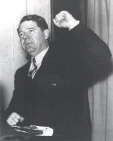
Huey Long | 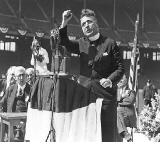
Father Charles Coughlin | 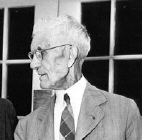
Dr. Francis Townsend |
THREE FIERY
CRITICS
Perhaps the
toughest critics the president faced, however, were three men who expressed views that appealed to
poor Americans: Charles Coughlin, Francis Townsend, and Huey Long.
One of President
Iloosevelt's most vocal critics was Father Charles Coughlin, a Roman Catholic priest from
a suburb of Detroit. Every Sunday, Father Coughlin broadcast radio sermons that combined eco nomic,
political, and religious ideas. Initially a supporter of the New Deal, Coughlin soon turned against
Roosevelt. He favored a guaranteed annual income and the nationalization of banks . At the height of
his popularity, Father Coughlin claimed a radio audience of some 40 million people, but his
increasingly anti-Semitic (anti-Jewish) views eventually cost him support.
Another critic of
New Deal policies was Dr. Francis Townsend, a physician and health officer in Long Beach,
California. He believed that Roosevelt wasn't doing enough to help the poor and elderly, so he
devised a pension plan that would provide monthly benefits to the aged. The plan was too expensive to
work, but it found strong backing among the elderly and it undermined their support for President
Roosevelt.
Perhaps the most serious challenge to the New Deal came from Senator Huey
Long of Louisiana. Long was a former traveling salesman, but he had studied law and become a
persuasive spokesman for the poor. He was elected governor of Louisiana in 1928 and later served in
the United States Senate .
Like Coughlin, Long was an early supporter of the New Deal, but he
soon turned against Roosevelt. Eager to win the presidency for himself, Long proposed a nationwide
social program called Share Our Wealth . Under the banner "Every Man a King," he
promised something for everyone .
Long's program for sharing the nation's wealth was
so popular that by 1935, he boasted of having over 27,000 Share-Our-Wealth clubs with around 7 .5
million members. In 1935, however, at the height of his popularity, Long was assassinated by a lone
gunman .
As the initial impetus of the New Deal began to wane, President Roosevelt started to
look ahead. Ile knew that a lot more needed to be done to help the people and to solve the
nation's economic problems .
| | | |
|
|
|
25.
|
Which Roosevelt critic was
accused of being anti-semetic (anti-Jewish)?
|
|
|
26.
|
Which Roosevelt cirtic had the
“Share Our Wealth” program
|
|
|
27.
|
Which Roosevelt critic was a
former Governor and Senator?
|